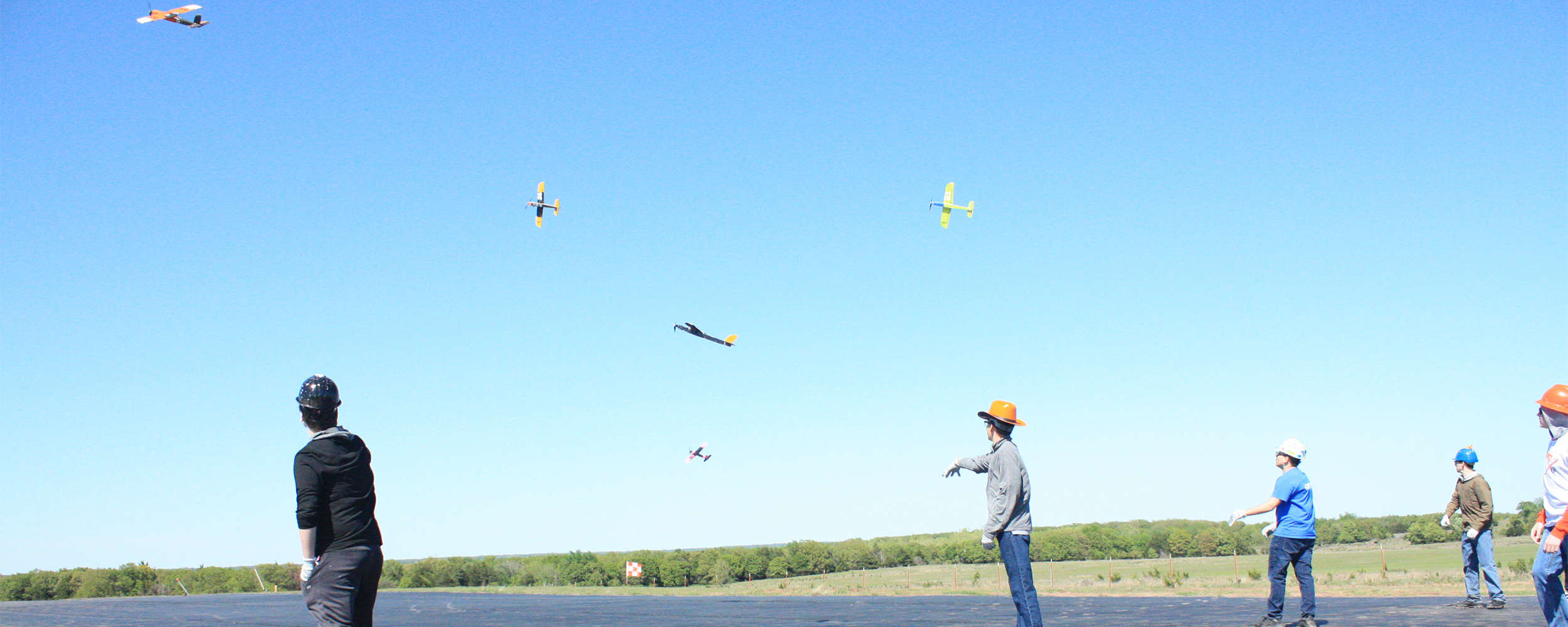
Speedfest 2023 breaks records
Tuesday, May 30, 2023
Media Contact: Dakota Keith | Events Coordinator | 405-744-1292 | dakota.keith@okstate.edu
On a warm and blustery Saturday, the Oklahoma State University College of Engineering, Architecture and Technology (CEAT) hosted its 12th annual Speedfest event April 29 at the OSU Unmanned Aircraft Flight Station in Glencoe, Oklahoma.
Speedfest is an aerospace competition where engineering students from OSU, and middle and high school students across the state come together to demonstrate their engineering prowess in friendly competition.
Speedfest hosts two main competition categories each year: Alpha Class, which is the category for collegiate competition; and India Class which is the category for middle and high school competition.
In the Alpha Class competition, two teams, Team Orange and Team Black, of more than 20 interdisciplinary senior students come together to design and manufacture a remote-controlled, high-speed plane. Each year, Dr. Andy Arena — Speedfest coordinator and professor in the School of Mechanical and Aerospace Engineering — comes up with different competition parameters that each team’s plane must complete.
This year, each team was tasked with designing a cost-effective and durable plane that could reliably demonstrate speed and efficient pylon-racing capabilities. The planes were scored at the event based on how well they completed a rocket glide paired with a pylon race, a maximum speed competition and an endurance challenge. This year, Team Black won the overall competition, receiving a high score in the pylon race and endurance test, but it was Team Orange that developed the fastest plane in Speedfest history, reaching speeds of 240 miles per hour during their speed test.
“Speedfest is one of the largest competitions of its type in the world,” Arena said. “To date, there have been over 10,000 spectators, 1,400 students and 300 college faculty and K-12 teachers participating.
“At the collegiate level, the students are designing and building their aircraft using state-of-the-art tools and techniques, gaining knowledge that they will need to work in industry."
Industry judges that participate in Speedfest represent major aerospace companies and one judge described the experience as truly exceptional.
“I was blown away by the quality and capabilities of the aircraft, the professionalism of the student’s display areas and the overall experience that Speedfest delivered," a judge said.
The India Class is an invitational competition that is open to 5th-12th grade teams. Their mission is to construct a provided plane kit to try to improve the plane’s performance; modifications are allowed as long as they fall within certain restrictions. Each team’s plane then competes in a pylon race. Scoring is based on the distance traveled by the plane on a two-turn course in two minutes. There are turn markers spaced 400 feet apart on the course, and planes are flagged as they pass to determine their total distance completed within the time constraints. This year, a record 31 teams competed in the event.
“Our India Class numbers were up by 14 teams, and a total of more than 270 students competing this year, as we only had 17 teams compete in 2022,” said Dorinda Risenhoover, education coordinator for the NASA Oklahoma Space Grant STEM (NASA OKSG STEM) Education Center. “And I think this increase is greatly due to the NASA OKSG STEM Education Center taking over the pre-competition side of the India Class in 2022, in order to provide around the clock build assistance to these 5th through 12th grade teams.”
This assistance included virtual meetings so that teams could ask questions and educator professional development events, as well as the supply of extra parts, which ensured educators were not having to use personal funds to purchase parts for the competition.
In addition to the build assistance, CEAT’s K-12 Department of Defense STEM Grant provided $25,000 in funding, which covered travel costs; safety helmets (which are required to be worn when the planes are flying) and plane decorating materials for five teams that were in the districts supported by the grant; extra supplies during the competition for all 31 teams so that they could make repairs and purchase new items for their plane as needed; and all of the supplies for 13 of the teams to complete all 12 of the hands-on discovery and inquiry based NASA OKSG India Class Speedfest Curriculum lessons which reached 150 students. Halliburton provided funding for lunch at the event for the 31 India class teams and the Oklahoma Aerospace Commission provided more than $15,000 in funding for the competition.
“At the moment, we currently have enough returning teams and prospective new team names on the waiting list who wish to be considered for an invitation to Speedfest 2024, that we could easily see the team numbers increase to 60 plus,” Risenhoover said.
When Risenhoover asked for feedback from educators and participating students about the impact of the Speedfest program, here are a few answers she received.
“Too often we teachers push higher academics without implementing concrete, real-life applications of our theoretical lectures,” an educator said. “Speedfest requires students to complete hands-on work, become an active participant, work as a team to solve a common goal, learn to delegate, learn to lead, learn to overcome failures, practice time management, and it gives students more confidence in themselves while they have fun.”
A student participant stated, “I believe, no matter who you are going to be, you will use and need a STEM class to help you in pursuing and maintaining your career.”
Outside of the competition, Speedfest featured senior capstone design displays, sponsor tents and food vendors. During breaks in the competition, the crowd was treated to demonstrations by the Stillwater RC Flyers, rocket launches by CEAT students on the rocketry team and a CEAT sophomore versus senior race between the sophomore-designed rocket car and the senior-designed autonomous firefighting vehicle.
More photos: https://flic.kr/s/aHBqjAFRMk
